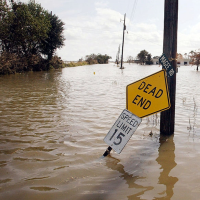Flooding in Southern U.S. Seen as Validating Scientists’ Predictions of Climate Change Effects
 Street in southern Louisiana, August 2016 (photo: Scott Olson, Getty Images)
Street in southern Louisiana, August 2016 (photo: Scott Olson, Getty Images)
By Jonah Engel Bromwich, New York Times
Climate change is never going to announce itself by name. But this is what we should expect it to look like.
That is what many scientists, analysts and activists are saying after heavy rains in southern Louisiana have killed at least 10 people and forced tens of thousands of residents from their homes, in the latest in a series of extreme floods that have occurred in the United States during the last two years.
That increase in heavy rainfall and the resultant flooding “is consistent with what we expect to see in the future if you look at climate models,” said David Easterling, a director at the National Centers for Environmental Information, which is operated by the National Oceanic and Atmospheric Administration. “Not just in the U.S. but in many other parts of the world as well.”
The flooding in Louisiana is the eighth event since May of last year in which the amount of rainfall in an area in a specified window of time matches or exceeds the NOAA predictions for an amount of precipitation that will occur once every 500 years, or has a 0.2 percent chance of occurring in any given year.
Louisiana joins five other states, most of them in the South, that have experienced deadly flooding in the last 15 months, including Oklahoma, Texas, South Carolina and West Virginia.
In the last three months alone, floods in Maryland, West Virginia and Louisiana have combined to kill dozens of people and damage tens of thousands of homes and vehicles.
The National Weather Service reports that parts of Louisiana have received as much as 31 inches of rain in the last week, a number Easterling called “pretty staggering,” and one that exceeds an amount of precipitation that his center predicts will occur once every 1,000 years in the area.
Easterling said that those sorts of estimates were predicated on the idea that the climate was stable, a principle that has become outdated.
“This is exactly what scientists have been predicting,” said climate activist Bill McKibben. “The basic physics are simple: Warm air holds more water vapor, something that is turning out to be one of the most important facts of the 21st century.”
To Learn More:
Rising Sea Levels May Disrupt Lives of 13 Million Americans (by Tatiana Schlossberg, New York Times)
Displaced by Nuclear Bomb Testing and then Flooded by Climate Change, Bikini Islanders want to Evacuate to U.S. (by Noel Brinkerhoff, AllGov)
“Unstoppable” Melting Glaciers Bring California's Future Flooding into the Present (by Ken Broder, AllGov California)
- Top Stories
- Unusual News
- Where is the Money Going?
- Controversies
- U.S. and the World
- Appointments and Resignations
- Latest News
- Trump to Stop Deportations If…
- Trump Denounces World Series
- What If China Invaded the United States?
- Donald Trump Has a Mental Health Problem and It Has a Name
- Trump Goes on Renaming Frenzy






Comments